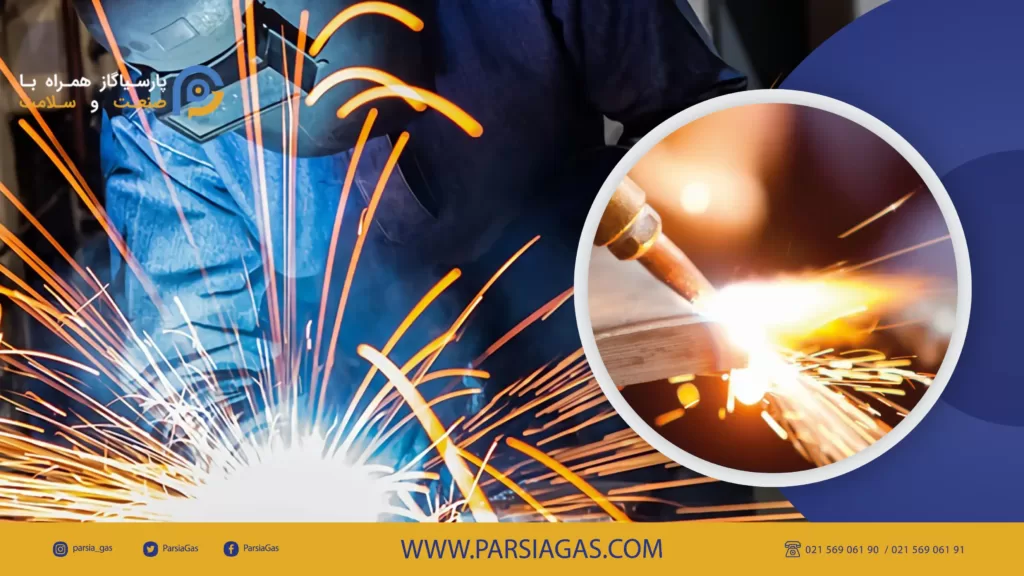Welding and 9 gas applications in this industry
Today, welding is the most common method of joining metals in the industry. When welding, two pieces of similar metal are joined together using heat, pressure, or both. After the welding process is completed, the welded joint is as strong as or stronger than the parts from which it is composed.
In general, welding is done by two methods, fusion welding and non-fusion welding.
- The gases used in welding and cutting processes are:
- Protective gases such as carbon dioxide, argon, helium, etc
- Fuel gases such as acetylene, propane, butane, etc
- Oxygen, which is used with fuel gases and also in small amounts in some shielding gas mixtures.

Types of welding
Gas welding:
Two metals are joined by fusing or fusing their adjacent surfaces. This work is done by guiding the gas flame on the metals to create a molten pit. Gas welding energy comes from the combustion of fuel with oxygen or air. Some of the most popular fuels include acetylene, MAPP gas, and hydrogen. Because gas welding is slower and easier to control than electric arc welding, brazing is often used for things like general maintenance work.
Arc welding:
Two metals are connected by creating an electric arc between the covered metal electrode and the base metal. Heat is generated by the arc, which in turn melts the metal and mixes the molten deposits of the coated electrode. The arc energy is supplied by a power source that supplies direct or alternating current.
The electrodes carry the current to form the arc, produce a gas that shields the arc from the atmosphere, and add metal to control the shape of the weld. When the arc strikes the coated electrode, the intense heat melts the top of the electrode. Metal drops from the electrode enter the arc current and deposit on the base metal.
The equipment required for electric arc welding is a power source, electrode holder, ground clamp, protective shield and protective clothing of the welder.
Oxygen and arc cutting:
Metal cutting in welding is cutting or removing metal by flame or arc.
- The most common cutting processes are:
- Oxygen cutting: The metal is heated by a gas flame and a jet of oxygen performs the cutting.
- Arc cutting: The intense heat of the electric arc melts the metal.
- Use of oxygen in welding
Oxygen is currently one of the raw materials of the welding industry. For cutting metals, oxygen flame has no rival. Cuts metal plates. The heat required for cutting, welding, melting can be obtained by the combustion of suitable fuel gases with oxygen, which is essential for all forms of combustion.
Oxygen in combination with hydrogen is used as fuel for welding torches.
- Oxygen is used instead of compressed air in burners, which aims to increase the thermal power of the flame.
Nitrogen in the welding industry
Nitrogen increases welding penetration and arc stability. Nitrogen-containing gaseous compounds can increase the mechanical properties of nitrogen-containing alloys and prevent pitting corrosion and nitrogen loss from the metal.
Nitrogen provides the necessary air for welding on any type of material.
Be sure to read: The use of argon in welding
Argon in the welding industry
Argon makes up 1% of air and is a byproduct of air reduction processes used to produce oxygen. This gas is suitable for protecting boils in a flat position and in deep groves.
Argon is suitable for easier starting and intermittent applications as well as for longer arcs at lower voltages. Argon is often used with aluminum and ferrous metals.
Adding helium improves the heat transfer properties of argon, and combining argon with carbon dioxide or oxygen can help stabilize the arc.
Argon gas is an inert gas that is used in welding in order to prevent the welded metals from oxidizing.
Dangers of welding gases:
- suffocation (lack of oxygen)
- Fire or explosion
- toxicity
How can exposure to welding fumes be avoided?
Following the manufacturer’s instructions, safety data sheets (SDS) and safety protocols is very important to minimize the hazards of welding gases.
- Use alternative materials such as water-based cleaners or high flash point solvents.
- Cover the bathroom or kitchen utensils.
- Do not weld with fat solvent on surfaces that are still wet.
- Avoid welding near degreasing tubs.
- Do not use chlorinated hydrocarbon degreasers.
- Provide adequate ventilation in the workplace to prevent displacement or enrichment of oxygen and to prevent the accumulation of flammable atmospheres.
- Use local exhaust ventilation systems to remove fumes and gases from the welder's breathing area.
- Use appropriate respiratory protective equipment.
- Respiratory protective equipment should not replace the use of mechanical ventilation.
Be sure to read: The gas used in welding!
